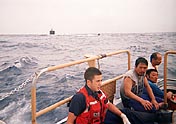 Survivor search halted Survivor search halted
 A Tribute to the Missing A Tribute to the Missing
 Previous stories Previous stories
By David Waite
Advertiser Staff Writer
New information released yesterday by the National Transportation Safety Board shows that the USS Greeneville used its periscope to check for surface vessels just three minutes and 20 seconds before it slammed into a Japanese training vessel on the surface.
 |
| The U.S. Navy submarine USS Greeneville is seen in the background as a member of the U.S. Coast Guard watches over some survivors of the Ehime Maru after the fatal collision Feb. 9.
Coast Guard photo |
The NTSB did not say how far it believes the Ehime Maru was from the Greeneville when the sub’s crew last checked to make sure no ships were in the area where it intended to surface.
But based on the Ehime Maru’s stated speed of 11 knots, a potential speed of 30 knots for the fast-attack submarine, and the new information, the vessels could have been no more than 2.6 miles apart when the sub completed its periscope check.
The collision, at 1:43 p.m. Feb. 9 about nine miles south of Diamond Head, tore a huge gash in the hull of the Ehime Maru, causing it to sink within minutes. Twenty-six people who were aboard the Japanese ship were rescued, but nine others, including four 17-year-old high school students, remain missing and are presumed dead.
The submarine’s commanding officer, Cmdr. Scott Waddle, has said he did at least two 360-degree periscope sweeps minutes before the Greeneville began a rapid ascent procedure, and saw no surface vessels in the area. Fifteen of the 16 civilian guests who were aboard the Greeneville when it hit the Ehime Maru have told NTSB investigators they did not see any ships on the ocean’s surface as they watched video monitors aboard the submarine that showed them what Waddle was viewing through the periscope.
And while one guest reported seeing what she thought was a surface ship on a monitor she was watching, she later reviewed pictures of the Ehime Maru and told investigators she did not believe it was the vessel she had seen. The periscope images were not recorded.
Waddle seeks immunity
The Navy is scheduled to open hearings into the accident Monday at Pearl Harbor, focusing on the actions of the Greeneville’s officers.
Navy lawyers yesterday were reviewing a request from attorneys for Waddle seeking "testimonial immunity" for Waddle during next week’s hearings, The Associated Press reported.
Testimonial immunity would prevent military lawyers from prosecuting Waddle based upon anything he says during the investigative hearing, according to military legal expert Eugene Fidell, president of the National Institute of Military Justice in Washington. However, Waddle still could face prosecution based upon the testimony of others.
Lawyers for Adm. Thomas Fargo, who convened the hearings, were reviewing the request.
Equipment worked
Why the crew aboard the Greeneville failed to realize the Ehime Maru was nearby when it undertook "an emergency main ballast blow" that sent it rocketing toward the surface is at the heart of the NTSB investigation. Navy officials have told NTSB investigators that the sub’s sonar and periscopes were examined after the accident and found to be in proper working order.
According to the sequence of events outlined yesterday by the NTSB, based on information provided by the Navy, the Greeneville rose to an initial periscope depth of 63 to 67 feet (keel depth) at 1:38:30 p.m. Hawai‘i time. It then rose 3 feet higher a minute later, making the total time at periscope depth about one minute, 30 seconds.
(A Washington Times report last week quoted a Navy report on the initial findings of the accident: "The ship was at periscope depth for an estimated two minutes, which significantly limited opportunities for visual and electronic emitter search and detection.")
At 1:40 p.m., the Greeneville began its dive while on a compass heading of 120 degrees. About a minute later the submarine began to change direction toward the left. Two minutes after starting the dive, it reached a maximum depth of about 405 feet, and its bow was pointed toward a heading of 28 degrees.
The Greeneville began its rapid ascent to the surface at 1:42:30 and collided with the Ehime Maru about 50 seconds later.
At the time of the collision, the Ehime Maru was on heading of 166 degrees, or south-southwest, while the Greeneville was on a heading of approximately 18 degrees, or just slightly east of due north.
Not included in the latest information, however, was any indication of how close the Ehime Maru may have been to the Greeneville while the submarine scanned the surface with its periscope.
Submarine’s ‘black box’
NTSB officials said the Greeneville was equipped with a "sonar data logger" that recorded the Greeneville’s sonar contacts and the submarine’s movements through the water every second.
Safety board member John Hammerschmidt, who accompanied NTSB investigators to Hawai‘i and conducted press briefings on the investigation, likened the sonar logger to the so-called "black box" carried on airplanes to provide investigators crucial information in case of a crash.
The NTSB is waiting to analyze the data retrieved from the submarine’s sonar logger. The information released yesterday was based on preliminary data supplied to the agency by the Navy.
[back to top] |

